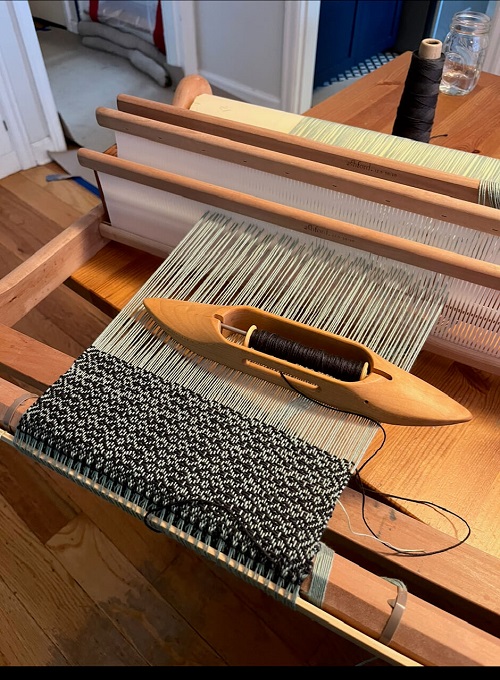I am not, by nature, a patient person. I like that weaving is much faster than knitting and crocheting, and that making woven patterns with shafts is quicker than hand embroidery. But, lately, I have fallen in love with slower weaves that require hand-manipulating warp ends or fancy supplementaI weft details. I also love using handspun yarn to create my own fanciful cloth. I have noticed that these woven articles are the ones I reach for over and over again.
It seems that my brain is learning to slow down and take a bit of time with what I am doing. I think I can attribute this change completely to my weaving practice. What used to be impossibly slow a few years ago, seems relatively fast to me now. Being able to harness your own patience to make slower weaves will open up a world of creative possibilities and help you challenge yourself more. So, here are my tips for reframing slow weaves and learning to adapt to them.
Tip 1: Have two looms, one for the slower project and one for the faster.
I set up two looms. One will have a weave that needs a lot of attention and time, and the other is a fast “palate cleanser”. Of course, this means having two looms, but it’s a good way to utilize a table loom or rigid heddle alongside a floor loom. Put the faster project on the floor loom and the slower one on the small loom. If you are working on a pick-up double weave or complicated tapestry that takes a lot of time, you might as well do it on slower equipment instead of tying up your faster loom.


Tip 2: Create smaller daily goals.
The first multi-heddle weave I did felt like it took forever and I was convinced I would be weaving it until I was 95 years old. To manage my anxiety about how long it was taking, I tracked how many lift sequence repeats I could do in 30 minutes and tried to finish that every day. I recorded what I wove on a piece of paper so I could physically check it off. It gave me permission to stop and take a break and left me with the feeling of completion every day to focus on instead of how slow it seemed to be taking. And it turned out the project didn’t take 50 years, just a few days.
Tip 3: Gather community support
I use my monthly local guild meetings as a “due date” for my more complicated projects. I set a goal to have one new multi-heddle or hand-manipulated weave every meeting, or at least a sample of what I am designing. Having members stop to talk to me about what I am working on keeps me focused! You can use the Handweaving Academy’s monthly “Whats on your Loom” post in forums or start your own cheerleading crowd who will get you past the hump of a larger, slower project.
Tip 4: Stop obsessing over how slow things might seem.
In my experience, it’s easy to get caught up in how slow something will be in our heads and we start the project already afraid of it. It’s amazing how many times I have dreaded trying a new weave technique only to do it and realize it’s not as hard as I thought it would be.
Tip 5: Know when to say when.
Give yourself permission to pull an especially challenging project off the loom. Before you do that though, make sure you’ve given it a fair go. In my experience. The first 12-24 inches of a new weave are the hardest, but if it’s not getting significantly better or easier after I have woven a few feet, I give myself permission to cut it off.
Tip 6: Balance your design
If you want to add some time-consuming techniques to your project, consider only adding them in some sections and using a faster weave between them. For example, instead of adding an all-over supplemental brocade design, I might add it to a few sections in the cloth with a faster plain weave between them. You can do this if you have a complicated lift sequence or weft color change sequence as well, plot out a few areas where you have a simpler lift sequence to make the project more doable and less overwhelming.

Tip 7: Eyes on the Prize
Remember that investing an extra week or two will yield years of pride. Unless you are production weaving or have a deadline, there really is no harm in spending a few extra weeks finishing a project. We have a society that values speed and it’s hard to fight against that internal monologue sometimes. But at the end of the day, the items I really spent time perfecting and designing are the ones that I live with the longest and the ones I cherish more. A few years later those added hours won’t matter so much to you when you have a beautiful table runner or shawl you are proud of.
Tip 8: Even slower weaving can be quite productive
If you can reasonably finish 6” of weaving in a day consistently 6 days a week for a year, you can end the year with over 52 yards of handwoven cloth. At the end of the day, production isn’t just about speed, it’s also about consistency. Build weaving into your daily life as a practice and one day you’ll realize you are out of warp without even realizing how much you’ve wove.
I hope these ideas inspire you to try something new that you’ve been afraid to start because it might take too long. Something that is completed slowly, is still completed, and you might surprise yourself with the extra hours of enjoyment you get in the creation.

